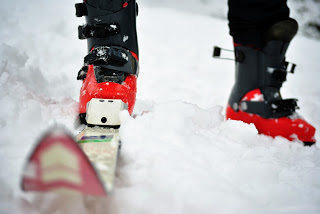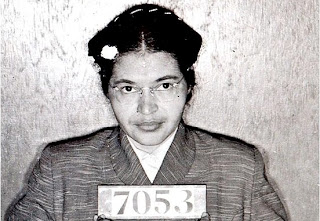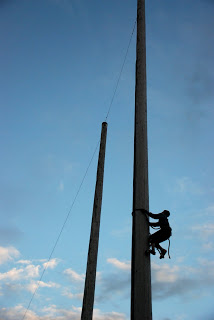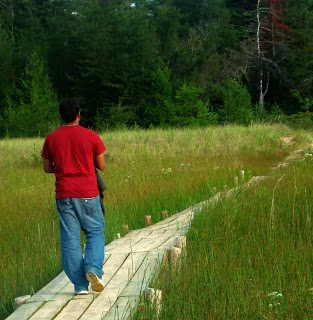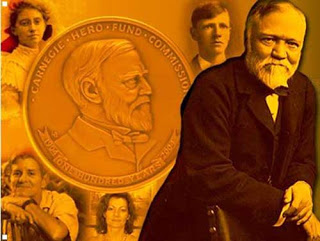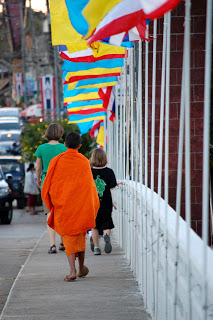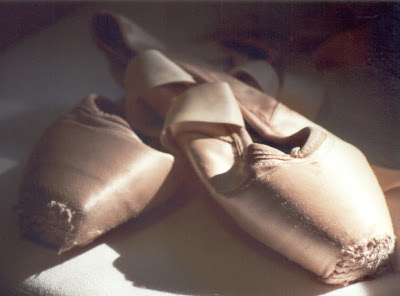
Over the winter I sat down with my good friend, Jane Haugh, a former professional ballet dancer, to talk about
physical courage. Specifically, I had questions for her about her experience with and understanding of pain, and how it relates to her role as a mother of three. Our conversation was a long one covering three distinct topics relating to pain and physical courage, so I’ll offer the adaptation of our dialogue in three parts. To avoid confusing our first names (Jane and Jen) I’ll refer to us by our last names, Haugh and Armstrong.
I began by asking her about when she started ballet, what it entailed, and when she knew she wanted to become a professional dancer, despite direct experience of the pain that would involve.
Haugh: I was very little when I started ballet class, maybe six or seven, and I was 12 when I decided I was very serious about it. This involved lots and lots of class and going on pointe, which is painful.
-->There was an aesthetic, there was a dream of something which made getting blisters on your feet okay. There were a bunch of different components. One was that you had graduated to a point where you could wear these very special shoes and then the fact that they hurt was – the mystique around them was enough to keep you going. Then the other part was that there was a bit of a culture around, “How many blisters do you have? I have four.” “Oh, I only have two.” It’s like when you learn to play violin when you’re very young and you get blisters on your fingers – those kids are also talking about it as a badge of achievement. “I worked so hard that I have more blisters than you do.” I think that there was a point at which blisters hurt and there were coping mechanisms for that – things you could put on your feet, things you could wear in your shoes to try and help that. And there was this other pain that had to with fatiguing your muscles and getting to the point where you worked yourself so hard that the next day you were very sore. Or you pulled something slightly – not enough to stop but enough to know that you hurt.
-->You weren’t a serious dancer unless you were having some pain.
Armstrong: Did you ever have a conversation with an adult about that? Like the teacher or your parents?
Haugh:
-->There were two different conversations. One conversation was with the teacher: “Oh my feet really hurt,” and the teacher said, “Everybody’s feet hurt and if you don’t want to do this you should go do some mundane job, like maybe you could go become a secretary, dear.” So there was this subtle put-down that this is what it’s about: either you tough it out and keep going or you step out because someone else will take your place. When I had conversations with my parents about it they would say, “Stop! If it hurts so much you should stop.” But I really wanted to be that dancer, that person on stage wearing that costume. And so them saying “stop” wasn’t a solution for me. I wanted someone to make it stop hurting and nobody could do that. So there has to be a goal, and that goal has to be so important that even though you have these conversations – like my parents kept saying that’s not okay that your feet are bleeding, stop. But
-->it was entirely up to me. My parents said, this is crazy, you should stop, but then when Tuesday came around I went to class. Or I said I wanted to go to class, and they would ask didn’t my feet hurt and I would either lie and say they didn’t, or say they did but I still wanted to go.
Armstrong:
-->So, as a parent, looking back on that, what do you think about that? Because after all you did end up with this career, with achieving this dream of becoming a professional dancer, so if you were in a position to counsel your parents in that moment, would you say “make her stop,” or would you say “yes, it’s painful and maybe she’ll hurt herself but this is really important to her dream, her goal.”
Haugh:
-->I didn’t let Z. [her elder daughter] do ballet but I think it’s probably for other reasons. There certainly are things about neoclassical ballet that are bad for your body, like arthritis in your hips and stress fractures in your feet, but mostly I didn’t want the competitiveness and aesthetic stringency and criticalness of that world. I didn’t want that for her. But the physical stuff – I think that’s okay. I think it depends on the culture within which that physical stuff happens. I think ballet culture specifically is slightly ill, and therefore not healthy and not something I wanted for my daughter, but I think mountain-climbing culture is not ill, or not in that same way, and so when you take your kids on a hike and they start complaining, they’re tired and their feet hurt, getting to the top of the mountain is still a worthwhile goal, and the things that you learn by making yourself or making your children get to the top of the mountain are so worthwhile. I’ve talked to Z. about it a little bit: the things I learned as a dancer had to do with how far you can go and even though it hurts you’ll be okay the next day.
Armstrong:
-->: Let’s talk about being a mom. You’re raising three kids in an environment that we could call very physical [High Peaks region of the Adirondack Mountains]. Lots of outdoor activities, a very cold winter climate. What decisions have you made about when you know your child is cold, or tired, or uncomfortable, and yet it’s – this is our lifestyle, this is what we do.
-->Right, and we’re not all going to stop. There are a couple of things that I think I learned dancing that I’ve tried to teach my kids. One of them has to do with being tired. When you’re really tired, and you’re on a hike, and you’re not there yet, but you’re close enough that if you really put on a push you could get there – what I know about being tired from dancing is that if you pretend not to be tired for a couple of minutes, you will find more energy. It’s a phenomenon that we learned in the studio. You’re really tired and you’ve run the thing fifteen times and the rehearsal master says we’re going to do it one more time and everything in you says “oh god, no!” but you know you are going to have to do it again. You go back in your corner. You take a deep breath, and when the music starts you come out with 150%, because if you can gather that and put it out there it will carry you through. You’ll make it and be okay. You’ll find the energy. And that’s something that I don’t think most people – most adults – don’t know. That they can do that. When we go on hikes and we get to that point I say, “Okay, we’re going to stand here, and I’m going to count to three, and then we’re going to run. I know you can. We’re going to run, and we’re going to yell as we run, and we’re going to run up this mountain.” And you find that if you can get them over that hump and they yell and they run they’re laughing and then they’re walking again, and then when you get to the top of the mountain you can say, “See!? This is where we got to! And you guys were so tired and that was twenty minutes ago!”
-->
We have a rule at the mountain because it’s often very cold at Whiteface and yet we all like to ski. You’re not allowed to talk about being cold. You can stay inside. But don’t complain. Don’t say the word “cold.” We all get in the gondola, and we can say “Wow, what’s the temperature!?” but saying “my feet are so cold!” No. I say, “then go in.” But don’t ski and complain. You can choose to ski, or you can choose to go in. And a lot of times when they were littler they would choose to go in. M. [younger daughter] especially would choose to go in. But then she’d see us come down, and we’d be laughing and skiing and she’d come back out again and she’d ski longer than I thought she would.
Please join us in for the second part of this interview on dancing through the pain, an apt metaphor for much of life by clicking here: /2012/05/dancing-through-pain-part-ii.html And please feel free to share your thoughts about pain, physical courage, and how you feel about your kids doing physical activities that may hurt them..

